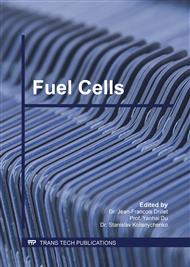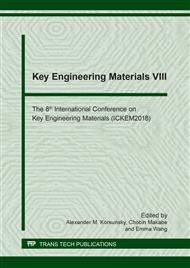p.305
p.311
p.317
p.323
p.331
p.336
p.342
p.350
p.359
Effect of Precursor Grain Size on the Sinterability and Conductivity of Commercial Yttria-Stabilized Zirconia as Solid Electrolyte
Abstract:
Solid oxide electrolysis cell (SOEC) and solid oxide fuel cell (SOFC) have been receiving significant attention for future energy storage and hydrogen production applications. This research focuses on the electrolyte material which can be used for both SOEC and SOFC particularly on 8 mol% yttria-stabilized zirconia (8YSZ) electrolyte material. YSZ has been used because of its high stability at elevated temperature, excellent mechanical and chemical properties and its excellent oxygen ion conductivity. This study aims to determine the effect of precursor’s grain size and sintering temperature on the properties of YSZ as electrolyte material for SOEC. Solid-state sintering was done to transform the ceramic powders into solid compacts. Pure cubic fluorite structure YSZ was achieved by both micrograined and nanograined YSZ sintered at 1200°C and 1500°C. It was observed that the micrograined YSZ sample sintered at 1500°C achieved the highest relative density at 99.48%. SEM images showed a smooth and compact microstructure for micrograined YSZ while small pores were still present in the micrographs of nanograined YSZ. However, interestingly, the nanograined YSZ has higher total conductivity as compared to the micrograined YSZ.
Info:
Periodical:
Pages:
331-335
Citation:
Online since:
August 2018
Keywords:
Price:
Сopyright:
© 2018 Trans Tech Publications Ltd. All Rights Reserved
Share:
Citation:



